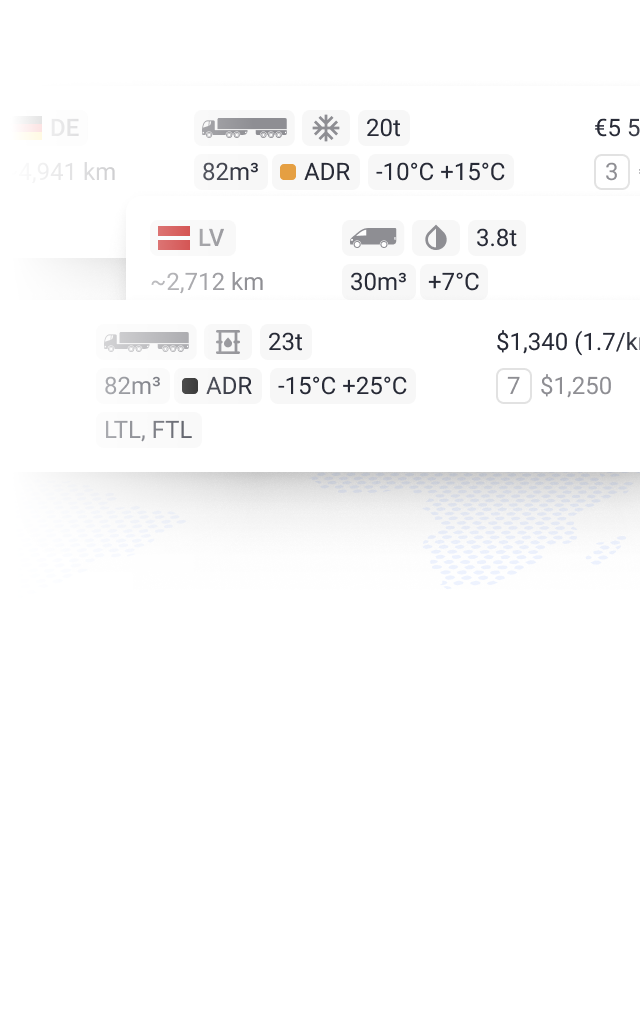
General Cargo Transportation



















A general cargo shipment refers to goods from a single customer for which a standardized module (container) or transport unit — such as an airplane, train car, small vessel, or truck — is fully allocated. Goods from other contractors are not loaded, even if there is unused space. Instead, empty spaces are filled with spacers or shock absorbers to prevent the movement of the transported products.
The transportation of general cargo is often referred to as FTL or FCL shipping. The first abbreviation stands for Full Truck Load ("Full truckload"), while the second means Full Container Load ("Full container load").
The opposite concept is consolidated cargo (LTL or LCL). This refers to goods from multiple shippers that are placed into a single transport unit or container.
Only unitized cargo can be classified as either general or consolidated. Liquid, bulk, or loose materials inherently occupy all available space by definition.
Unitized cargo can be either packaged or unpackaged. The first type refers to goods transported in packaging, such as boxes, crates, or barrels.
General cargo transportation is most often used for delivering chemicals, bagged bulk construction materials, big-bags containing non-ferrous metal ores, household appliances, and other consumer goods. To simplify loading and unloading operations, these items are often placed on pallets.
By placement method, goods are divided into stackable and non-stackable. Stackable goods have a regular shape, allowing them to be arranged in vertical rows. Examples include:
- wood, lumber, glued timber
- metal profiles
- reinforced concrete products
- bales of wool, rubber, etc.
- rolled steel
Where possible, goods are grouped into bundles or packages, which speeds up loading and unloading operations.
Non-stackable goods include metal structures, self-propelled machinery, engines, pattern casting, or similar products. Goods in this category come in a wide range of shapes and sizes, so there are no universal rules for securing them during transport.
Cargo weighing up to 5 tons is classified as lightweight, while heavier items are considered heavy. If an item does not fit on a standard platform, it is categorized as oversized. Transporting such goods requires multiple trailers or specialized low loaders.
Cargo exceeding the dimensions allowed by transportation regulations is classified as non-standard (oversized). These items are transported with special precautions.
General cargo transportation can be carried out using all types of transport. The choice depends on the weight and size characteristics of the goods, geographical features of the route, and the urgency of the order.
Overland
For moving general cargo overland, road or rail transport is used. Road transport offers the following advantages:
- door-to-door delivery capability
- no dependency on a fixed schedule
- high speed
- ability to travel the shortest route
The disadvantages of road transport include higher shipping costs and lower load capacity.
For long-distance transportation, rail transport is more cost-effective. Its advantages include:
- low shipping cost
- high load capacity
- low probability of accidents
A disadvantage is the inability to deliver goods directly from and to warehouses. Road transport must be used for the initial and final stages of the route.
By Water
General cargo shipping by sea has the following advantages:
- the lowest tariff
- no restrictions on weight or size
- low fuel consumption per ton (important for environmental impact)
- ability to transport between continents or islands
- naturally occurring routes
- unlimited route capacity
Disadvantages include slower speeds and the inability to provide door-to-door delivery.
By Air
The load capacity of airplanes can reach up to 120 tons (e.g., An-124). This mode of transport offers the following advantages:
- high speed
- ability to move between continents and islands
- access to remote areas
- minimal vibration
- low risk of accidents
Disadvantages include high cost and limited load capacity.
General cargo is marked with a fraction symbol. The numerator indicates the impact that the goods may have on their surroundings, while the denominator shows what could potentially damage the goods. Examples include:
- “W” — water
- “D” — dirt
- “C” — corrosion
The shipper provides the carrier with the following information:
- coordinates of the consignee
- weight and dimensions of the transported product
- possibility of stacking
- a list of hazardous properties of the goods
- a list of safety precautions
The logistics company informs the client of the number of cargo units occupied by the shipment and assigns a place number to each unit. If third-party carriers are involved, their names are also specified.
The transportation of general cargo offers several attractive features for the client:
- Reliability — the transport unit is sealed in the presence of the shipper, and the seal remains intact until the goods are delivered to the consignee.
- High speed — there is no consolidation phase, and the goods travel directly to the recipient via the shortest route.
- Minimal documentation when crossing state borders.
- Choice of transport — clients can select the type of vehicle best suited to their needs.
- Simplified organizational process and control — fewer steps are involved in arranging and monitoring the shipment.
General cargo transport takes approximately 30% less time compared to consolidated shipments. The only drawback is the higher cost, as even with partial loading, the entire transport unit must be paid for in full.
The cost of transporting general cargo by a transportation company depends on several factors. The main ones are:
- type of goods — standard, fragile, perishable, hazardous
- type of delivery — domestic or international
- length and complexity of the route
- mode of transport
- weight and dimensions of the shipment, as well as the value of the goods
The cost calculation is done individually for each customer. To get an estimate, you can send a request to the logistics company or use the calculator on their website.
💡 Customers can use the functionality of a freight exchange platform to compare prices and find competitive rates. On the Roolz platform, you can also conduct auctions to receive offers from transportation companies and private carriers.
An appropriate company for delivering general cargo should have the following qualities:
- experience in freight transportation and logistics organization
- a good reputation
- direct routes to your destination
- the ability to prepare goods for shipment and provide storage services
- a license for transporting products like yours
- its own fleet of various types and load capacities
- a competitive pricing system
- well-established communication channels
- the option to assign a personal manager
It’s important to confirm how quickly the transportation company delivers general cargo and whether it provides a guarantee for the safety of the goods. It’s also beneficial if the carrier offers tracking services, as both shippers and consignees appreciate being able to monitor the progress of their shipments.
Finding a suitable partner is easy through the Roolz platform, where you can find up-to-date listings of transportation and forwarding companies specializing in the delivery of general and common cargo.
What is general cargo?
A general cargo shipment refers to goods from a single customer for which a standardized module (container) or transport unit — such as an airplane, train car, small vessel, or truck — is fully allocated. Goods from other contractors are not loaded, even if there is unused space. Instead, empty spaces are filled with spacers or shock absorbers to prevent the movement of the transported products.
The transportation of general cargo is often referred to as FTL or FCL shipping. The first abbreviation stands for Full Truck Load ("Full truckload"), while the second means Full Container Load ("Full container load").
The opposite concept is consolidated cargo (LTL or LCL). This refers to goods from multiple shippers that are placed into a single transport unit or container.
Only unitized cargo can be classified as either general or consolidated. Liquid, bulk, or loose materials inherently occupy all available space by definition.




Add your company


 en
en fr
fr de
de hi
hi pl
pl es
es tr
tr uk
uk